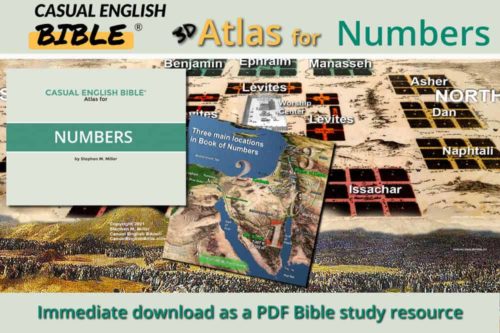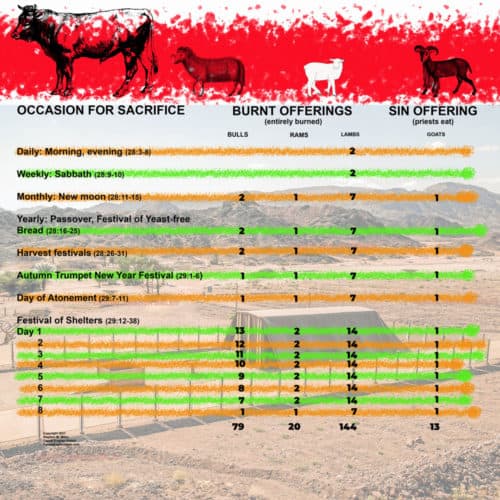Numbers 29
Sacrifices for autumn festivals
Autumn trumpet festival
1On the first day of the seventh month, [1] call the people in for a sacred time together. This is a day to blow the trumpets. 2You should give the LORD the sweet aroma of a burnt offering. [2] Bring one bull, one ram, and seven male lambs, each lamb a year old and in perfect shape—no defects. 3Bring grain offerings [3] of fine flour mixed with olive oil. This should accompany each animal, as follows.Bull: six quarts. [4]
Ram: four quarts
4Lamb: two quarts.
5For the sin offering, [5] sacrifice a goat. This will atone for your sins and get you on good terms with the LORD. 6This offering to the LORD should be in addition to the usual daily and monthly burnt offerings with their accompanying grain and liquid offerings. The smell of these offerings on the fire is a sweet aroma to the LORD.
Day of Atonement sacrifices
7Ten days into the seventh month [6] come together in a sacred meeting. Come in a spirit of humble reflection and fasting. [7] Don’t work on this day. 8You should give the LORD a burnt offering for a sweet aroma. Bring one bull, one ram, and seven male lambs, each lamb a year old and in perfect shape—no defects. 9Bring grain offerings of fine flour mixed with olive oil. This should accompany each animal, as follows.Bull: six quarts.
Ram: four quarts.
10Lamb: two quarts.
11For the sin offering, sacrifice a goat. Give this to the LORD in addition to the regular, daily sin offering that atones for your sins and gets you on good terms with the LORD. Same with the burnt offering. This one is in addition to the daily burnt offering, with the accompanying grain and liquid offerings.
Sacrifices for festival of shelters
12Five days later, on the fifteenth of the month, come together again in a sacred meeting. Take the day off. Celebrate it as the first day of a seven-day festival [8] honoring the LORD. 13Give the LORD a burnt offering. Sacrifice 13 young bulls, two rams, and 14 one-year-old male lambs. There should be nothing wrong with any of these animals. No defects at all. 14Accompany each bull with a grain offering made from six quarts of fine flour mixed with olive oil. With each of the two rams, bring four quarts. 15And with each of the 14 lambs, bring two quarts. 16Sacrifice one male goat as a sin offering. This is in addition to the daily burnt offering you give, along with the accompanying grain and liquid offering.Day two
17On day two of the festival, bring these offerings: 12 bulls, two rams, and 14 one-year-old lambs. No defects allowed. 18Add the prescribed amount of grain and liquid offerings for each animal. 19Bring one goat for a sin offering. This is in addition to the daily burnt offering you give, along with the accompanying grain and liquid offering.Day three
20Bring 11 bulls, two rams, and 14 one-year-old lambs. No defects. 21Add the prescribed amount of grain and liquid offerings for each animal. 22Bring one goat for a sin offering. This is in addition to the daily burnt offering you give, along with the accompanying grain and liquid offering.Day four
23Bring 10 bulls, two rams, and 14 one-year-old lambs. No defects. 24Add the prescribed amount of grain and liquid offerings for each animal. 25Bring one goat for a sin offering. This is in addition to the daily burnt offering you give, along with the accompanying grain and liquid offering.Day five
26Bring nine bulls, two rams, and 14 one-year-old lambs. No defects. 27Add the prescribed amount of grain and liquid offerings for each animal. 28Bring one goat for a sin offering. This is in addition to the daily burnt offering you give, along with the accompanying grain and liquid offering.Day six
29Bring eight bulls, two rams, and 14 one-year-old lambs. No defects. 30Add the prescribed amount of grain and liquid offerings for each animal. 31Bring one goat for a sin offering. This is in addition to the daily burnt offering you give, along with the accompanying grain and liquid offering.Day seven
32Bring seven bulls, two rams, and 14 one-year-old lambs. No defects. 33Add the prescribed amount of grain and liquid offerings for each animal. 34Bring one goat for a sin offering. This is in addition to the daily burnt offering you give, along with the accompanying grain and liquid offering.Day eight
35Take the day off work and get together in a sacred meeting. 36Bring the LORD a burnt offering: one bull, one ram, and seven one-year-old lambs. No defects allowed in any of these animals. 37Add the prescribed amount of grain and liquid offerings for each animal. 38Bring one goat for a sin offering. This is in addition to the daily burnt offering you give, along with the accompanying grain and liquid offering.39Bring these offerings to the LORD on time, during each of the sacred days and festivals that the LORD established. These are in addition to any offerings you bring in connection with vows you’ve made to the LORD, or with thanks you want to express, or with other special offerings you want to bring. 40Moses gave all these instructions to the Israelite people, just as the LORD said he should do.
Footnotes
This festival takes place in September or October. Many Jewish people today still observe the festival. They call it Rosh Hashanah, which means “head of the year.” It’s the Jewish New Year, a sacred two-day event. See Leviticus 23:23-25.
A “burnt offering” is the most common of the sacrifices. It’s one that consumes the entire animal and pays the price for sin, atoning for sin, and getting people back on good terms with God. Laws related to the burnt offering are in Leviticus 1.
Grain offerings were an expression of gratitude for a harvest and for the way God takes care of the Israelites. People offered the grain in several ways: ground to fine flour, presented as baked, fried, cooked, or roasted with olive oil.
Six dry quarts of flour is about 6.6 dry liters, which would be about an eight-pound bag of flour (3.6 kg).
A sin offering refers to something the people of Israel brought to God after they realized they had accidentally broken one of God’s laws earlier. Some scholars say a better translation is the opposite of “sin” because the sacrifice is intended to “un-sin” people, to purify them. So those scholars call it a “purification offering.”
September or October, Israelites followed a calendar based on the movement of the moon instead of the sun, which we follow. The Day of Atonement, known today in Hebrew as Yom Kippur, is the most solemn day on the Jewish calendar. In Bible times, the high priest appealed for the forgiveness of sins that the people of the nation had committed in the past year. Jews today typically fast all day, attend synagogue services, read Scripture and pray.
“Humble reflection and fasting” is one word in the original Hebrew language: ʽānâ. It’s a word that depends a lot on the context of the words around it. That’s because writers used it in many contexts with lots of different meanings: humble, self-denial as in fasting all day, humiliated, mistreated, dishonored. In the context of atoning for sin in the presence of God, fasting might seem most appropriate because that’s what people of faith often do when they’re afraid of what’s coming, or when they ask for forgiveness for a big sin.
Known as Festival of Shelters or Festival of Booths or Festival of Tabernacles, or Succoth, the Hebrew word for “shelters.” Once a year, when observing this festival, Israelites were to build temporary living quarters to commemorate the exodus out of Egypt, when Israelites lived in tents and similar shelters. See Leviticus 23:33-44.
Discussion Questions
- Sorry, there are currently no questions for this chapter.






